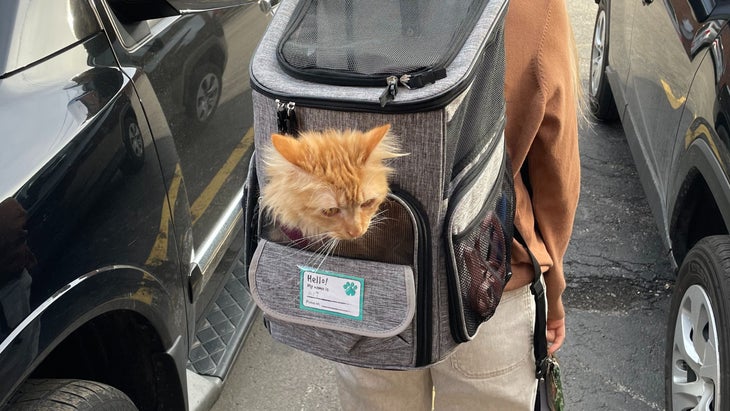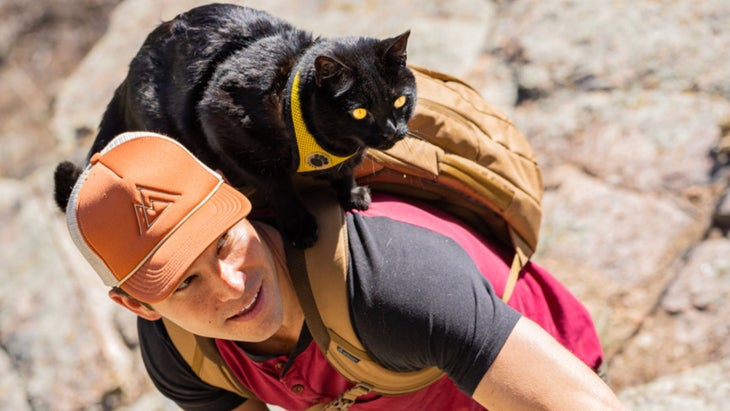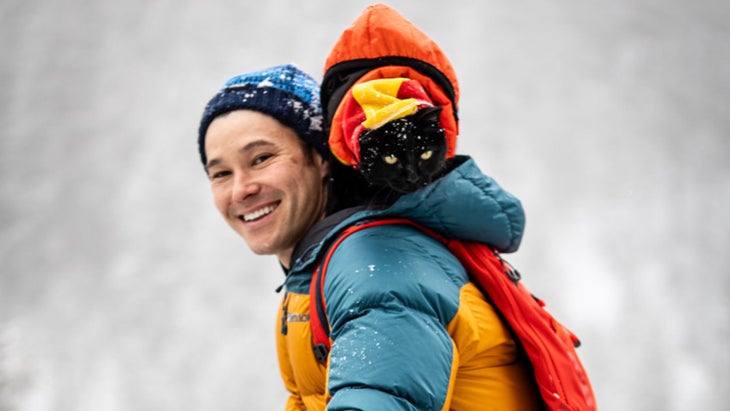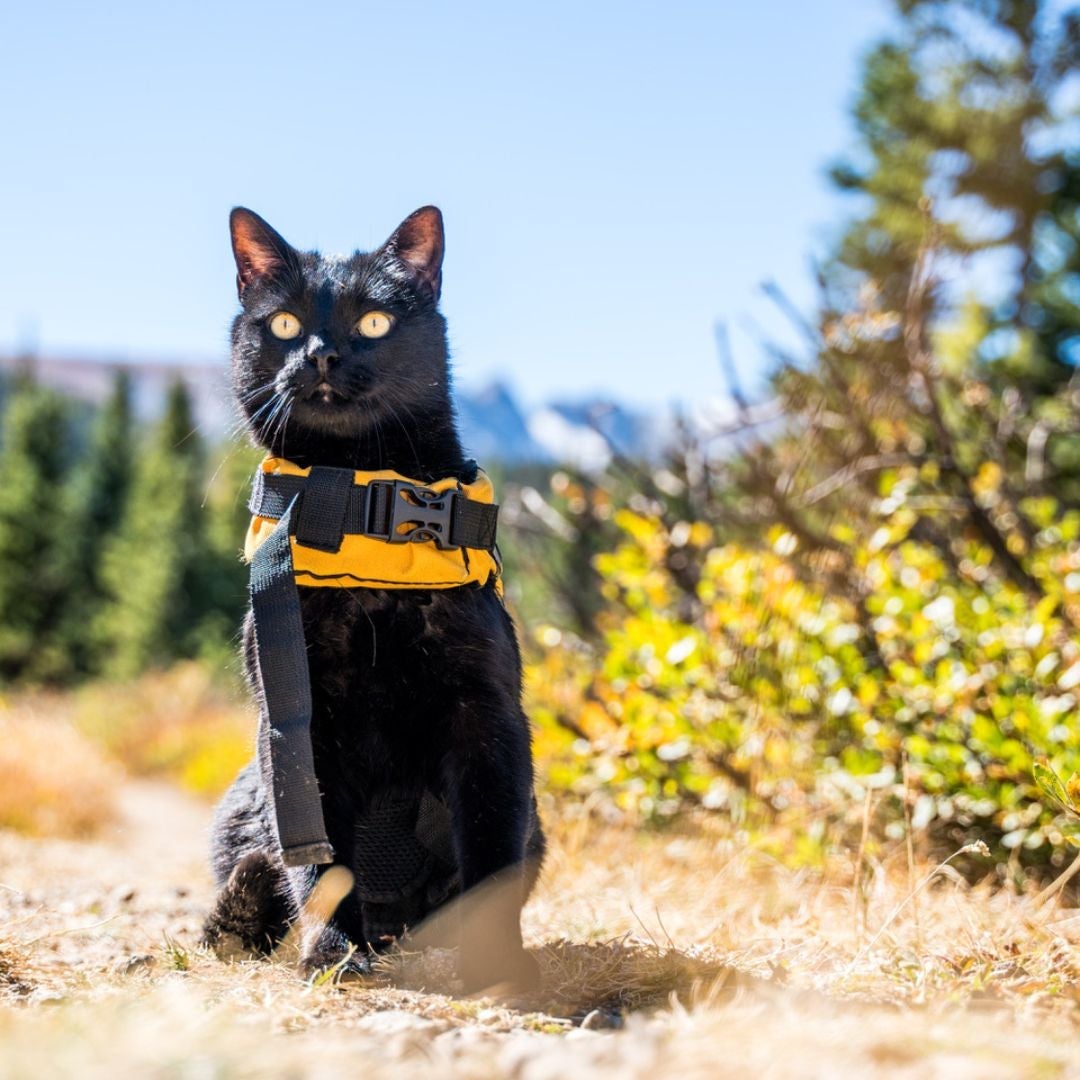It’s a Sunday morning and I’ve just run 16 miles. I’m drenched in sweat, out of breath, thirsty, hungry, and exhausted. When I step through the front door, my husband calls “hello!” from upstairs, but otherwise no one else greets me. I stretch on the floor, cooling my muscles down before melting into the carpet face-down. Suddenly, I feel a lump step onto my back, and my cat, Steve, proceeds to perform some expert-level kneading into my muscles. He then curls up like the perfect heating pad and purrs himself to sleep.
And it’s glorious.
Growing up with dogs, I always assumed I’d have one when I was older. There’s no denying that they’re the perfect running buddies, unwaveringly loyal, and no one can resist a goofy puppy smile. But then I adopted my first cat, Ari, and the definition of my ideal pet changed. Today, I have three cats—which is probably too many but if you like something you get one in every color, right?—and though they can’t run with me, I wouldn’t trade them for the most athletic, well-behaved dog in the world.
To preface: I love both cats and . I’d even add a pup to the family one day if the time was right. But cats are misunderstood, underrated pets for runners. Before you boo and hiss, hear meow-t.
The Secret Life of Cats

My first cat Ari and I would occasionally take to the trails on a leash or in a cat-safe backpack. She’s a little older now and prefers a life of indoor lounging, but at our peak, we’d go to parks and she’d climb trees while I held onto her leash down below. You might be surprised to know that some cats lead active, outdoorsy lives—and it’s a trend that’s gaining traction.
Eight years ago, Boulder-based influencer, filmmaker, and outdoorsman never anticipated that a cat could keep up with his on-the-go lifestyle, filled with hiking, climbing, swimming, backpacking, and trail running. But then Simon, now known as , was sort of thrust upon him. His landlord found a litter of stray kittens that needed rehoming, and Yosh felt compelled to take one.
“It was unplanned. I was traveling every weekend and not living a lifestyle that wasn’t even conducive for having a cat because I was going abroad a lot. The thought of getting a pet wasn’t even on my mind,” he says. “When I got Simon, it was kind of like, ‘I want to make him an adventure cat’ because everyone in Colorado has their Subarus and takes their dogs on the trails—I can do it too.”

Early on, Simon expressed the desire to be outside. But because Yosh lives in the backcountry, where it can be dangerous for cats to wander alone (coyotes, mountain lions, hawks, etc.) he started taking Simon out on supervised walks and hikes. Simon wears a harness and leash, but on longer hikes, likes to perch on Yosh’s back. And sometimes, these outings aren’t simple walks in the park. Yosh is an avid and has raced in ultras like the Collegiate Peaks Trail Run, Behind the Rocks Ultra, and the Run Rabbit Run.
Though Yosh doesn’t take Simon out on intense trail runs, when they’re out hiking together he can’t help dashing down ascents or running up hills, his cat either on his heels or his back. Together, they’ve summited several Colorado 14ers (mountains with summits exceeding 14,000 feet in elevation), including Torrey’s, Grey’s, Massive, Elbert, and Quandary.
“He’s always strapped in securely on my back,” Yosh says. “But he insists on exploring when we reach the summit—it’s like he knows he’s earned the view!”
They’ve even been camping in the snowy Indian Peaks Wilderness, which proved to be both challenging and rewarding with the amount of snow they had to trek through. “The cold didn’t phase Simon, though—he snuggled up in his gear and enjoyed every second of the snowy adventure.”

Yosh says that when he first got Simon, he rarely saw anyone outdoors with a cat. But over time, more and more felines are taking to the trails.
“At the time I never saw anyone with cats on the trails,” he says. “But more and more people seem to take their cats out on adventures.”
Take Sully, for instance, the “trail running cat”. The uber fluffy long-haired cat made waves when her owner, Katie Chen, posted a of them running along the trails together at an impressive pace. However, she’s clear on the fact that Sully is more of a sprinter than an endurance athlete, and doesn’t partake in long serious runs with her.
“Sully and I start our day with a 20-30-minute morning leashed walk,” Chen says. “I enjoy a cup of coffee and let him explore around our home. Sometimes he stares at birds, sometimes he eats grass, and other times he gets a case of the zoomies. It’s very peaceful and nice to ease into my day in nature. It’s routine for him, so he expects it every morning!”
With routine, practice, and lots of patience, your cats, too, can join you in your outdoor activities. If you’d like to start taking your cat outside, start by getting your feline acclimated to the harness and leash indoors. Yosh says that it took a lot of trial and error to find a harness that Simon liked, but says is his tried-and-true.
Have your cat wear the harness around the house for as much as they’re willing to until they get used to it. Then you can start taking them outside—preferably at the same time and place.
“A routine is helpful, such as walks at a regular time each day,” Chen says. “Once you start this, your cat may be very vocal about going back outside. An established routine will help avoid this and keep everyone happy.”
When you get your cat on the trail, just note that it’s going to be different than walking a dog.
“Cats don’t like to be restrained, and you want to give them enough leeway so they never feel like they’re trapped,” Yosh says. “You want to make sure the leash and harness move with the cat’s body. When I’m hiking with Simon, I always make sure I have a loose grip on the leash so he never feels constrained. Otherwise, your cat will resist you the entire time.
You’ll have the most success if you allow your feline friend to take the lead.
“You want to suggest things. You want to make cats think it’s their idea to go a certain way,” Yosh says. “And cats are going to go at their own pace. They react to every noise, every butterfly and lizard.”
He recommends that if you want to speed things up, you can use a pet-friendly backpack to carry your cat, or, as he does sometimes, have your cat rest across your back. That takes a lot of practice.
Ultimately, Chen and Yosh stress the importance of never forcing your cat into anything.
“Running around outdoors on a leash is not for every cat,” Chen says. “Your cat may not like it, and you have to be okay with that conclusion.”
An Argument for Cats, From The Mouth of a Runner
1. Cats sleep. All. The. Time.
My cats have improved my schedule, something everyone knows is essential to better recovery and running efficacy. Cats sleep about 12-20 hours a day. And even when they’re not sleeping, they enjoy mundane activities like looking out the window at birds, pacing the house, or batting around a toy mouse. My cats are usually conked out by 8 P.M., which honestly makes me a little sleepy, too. They encourage me to get to bed at a good hour.
Plus, cats make fantastic post-long run napping partners. Sometimes after I get home from an early morning workout, all I want to do is collapse on the floor and sleep. And your cat will absolutely join you, probably propping themselves right on your back and purring you into a lulled, wonderfully peaceful nap. They’re not interested in waking you up—in fact, they’d prefer if you just stayed right there all day and did nothing.
On the other side of the coin, cats will let you know when it’s time to start moving. They’re basically furry alarm clocks that wake you up early with pouncing and incessant meowing.
2. They’re the ultimate stretching partners.
Cats are stretching experts. And whenever I lay my mat on the floor, my cats are there to see to it that I get the work done. They are avid participants in my routine, but less intrusive than perhaps a dog might be (whenever I try to stretch around my brother’s golden retriever, she winds up barreling me over thinking I want to play—sorry Ruth!). They merely lay contorted in similar positions as you, occasionally climbing up onto your back and leaping nimbly off when you move. Not only does it make the whole process more fun, but it tremendously, which is especially useful after a run.
3. They force you to slow down.
When I’m in a training block, I have a one-track mind. And sometimes, my obsession with splits and progress can take over until I inevitably hit a wall and burn myself out. But cats live life one paw at a time, with no agenda, schedule, or rush. I once watched my cat slowly stalk an ant for 15 straight minutes. Cats encourage you to take it easy, slow down, and examine your surroundings.
This applies to when you’re out on the trails together, too.
“The thing about dogs vs. cats is that dogs like to please their humans, whereas you need to please cats, so it’s a very different mindset,” Yosh says. “The whole time I have Simon, I’m taking care of him. With a cat, because you have to be so attentive to their needs, you become more mindful and respectful of what’s happening around you.”
Yosh is so tuned-in to Simon that he can recognize a certain pitch in his meow that lets him know, if he’s on his back, that he needs to get down to go to the bathroom.
4. They offer just as much kinship as dogs.
I think one of most misunderstood preconceived notions about cats is that they’re cold, disinterested, and unloving. Cats can definitely provide affection, loyalty, and support. shows they recognize behavioral shifts and mood changes, which is why my cats seem to flock to my lap when I’m stressed about a quick deadline or sit protectively at my feet if I’m sick in bed.
“Simon definitely provides an extreme amount of emotional support,” Yosh says. “If I’m in a stressed mood, he’ll come over to me and demand I pet him as a way to take focus on whatever is stressing me out. It’s sort of a reminder like, ‘Hey life might be hard, but you have me.’ That reassurance is so comforting.”


